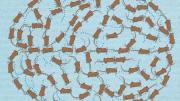In a darkened lab at Harvard Medical School, a mouse explores the bottom of a black bucket. Nosing forward, it turns to the right, rears up, then circles in the opposite direction. Nearby, a researcher watching the electrical activity in the mouse’s brain can predict, based on the neural signals being generated onscreen, what the animal will do next.
Scientists led by associate professor of neurobiology Sandeep Datta have developed insights into behavior based on the understanding that animals’ movements are assembled from small, constituent parts, each executed in milliseconds. Likening the construction of physical behavior to the construction of language, team members call these parts “syllables.” The brain, they say, strings these movement syllables together to assemble coherent actions that allow the mouse to forage for food, find a mate, or avoid predators. The human brain, they suspect, constructs behavior in the same way.
If they are right—and they published in Cell late in June the first strong evidence suggesting they are—their work could lead to earlier diagnoses of diseases that affect behavior, and to new methods for monitoring their progression. It could even aid in the development of drugs to treat conditions such as Parkinson’s, autism, and schizophrenia.
The idea that behavior at the level of an entire animal is constructed from a hierarchy of smaller constituent parts was first advanced in the 1950s by Nikolaas Tinbergen, a Danish scientist who in 1973 shared the Nobel Prize in physiology or medicine for his investigations of animal behavior. Tinbergen developed the theory from close observation.
But hard evidence that the brain builds behavior from parts has been lacking. That changed when Datta and his colleagues developed a tool called Motion Sequencing (MoSeq), which combines high-speed, three-dimensional videography with artificial intelligence to analyze animal behaviors in order to identify the smallest identifiable segments—the syllables—that make up animal motion. “We believe,” says Datta, “that there are rules about how those parts are placed in sequence over time to construct behaviors that allow animals to interact with the world and potentially to communicate with each other.”
To demonstrate a syllable, he plays a video that combines on one screen the behavior of 30 different mice, all expressing the syllable he calls “turn to the right.” MoSeq has identified this movement, which takes place in a few hundredths of a millisecond, as a fundamental unit of mouse behavior. A red dot illuminates the back of each mouse at the moment it initiates the specific move. Once the films of each mouse have been calibrated and combined so that the dot illuminates at precisely the same moment, the animals on screen appear to move in unison like synchronized swimmers. In the limited laboratory environments where Datta conducts his experiments, the researchers have identified a set of 40 to 60 unique syllables like this one (although they suspect mice may express thousands of syllables in more complex, natural environments).
The team also wanted to know whether adding a new stimulus to the familiar environment would lead to the expression of new syllables. They therefore put mice into square buckets, and blew air into each corner—and the mice explored each corner equally. Then they began blowing the scent of a fox into one corner, and the behavior of the mice changed dramatically: they sniffed, ran, and gravitated to the corner farthest from the unknown predator’s odor. But they did not display any new behavioral syllable: the units of movement expressed before and after the introduction of the fox scent were identical; what changed was the way those syllables were strung together. “What this means,” says Datta, “is that the brain has a kind of grammar of behavior. Through grammatical changes alone, the animal can run away from the fox and save its own life.” The brain, in other words, can string syllables together in different ways to compose new behaviors.
Next, Datta and his principal collaborator, Moorhead professor of neurobiology Bernardo Sabatini, an expert in neural circuit function, wanted to identify the place in the brain where this behavioral grammar is generated. Prior experimental evidence and studies of diseases that affect behavior suggested exploring the striatum, a structure in the middle of the brain that is critical for motor learning and the execution of movement. They began recording neural activity there and found they could correlate neural signals with specific behaviors, even predicting what the animal would do next.
Datta has recently begun collaborating with Justin Baker, director of functional neuroimaging and bioinformatics for the schizophrenia and bipolar disorder research program at Harvard-affiliated McLean Hospital, to explore the use of MoSeq with human subjects. With appropriate permission and oversight, they are recording manic and schizophrenic patients, in an effort to characterize objectively how underlying patterns of behavior are altered by these diseases. They also hope to use the tool to assess how the drugs those patients are taking alter their patterns of behavior.
“Now that we have much more powerful genetic and neurobiological tools for understanding variation in our genomes,” Datta explains, “it has become a little bit of a crisis” to understand the outputs of the genome and the brain. “That output ultimately is behavior. The brain evolved to help us find food, water, shelter, or a mate, and to avoid predation. Its goal is to generate behavior. But to understand what is meaningful in patterns of neural activity, and what is noise, what is helping the animal accomplish a goal, and what might be deleterious for an animal’s interaction with the world, you must have a much better understanding of how the brain constructs behavior.” This, he believes, is the path to understanding, finally, how the brain works.









